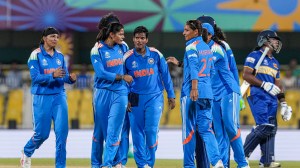Rajasthan falls off the map
FEBRUARY 26: He is on the brink of complete ruin. Umaid Singh of Osian village in Jodhpur has lost all but two of his 25 cows. His herd of...

FEBRUARY 26: He is on the brink of complete ruin. Umaid Singh of Osian village in Jodhpur has lost all but two of his 25 cows. His herd of 200 sheep has come down to 75. Facing a severe drought for the second consecutive year, water sources in Osian dried up and the village had run out of fodder. Umaid Singh’s animal stock steadily got depleted as a consequence and all hopes of growing a crop were dashed.
Forced to leave his home and hearth in Osian, he has taken shelter with his family and animals at Banwarla, where he has a relative, Prem Singh, who was willing to have him. The two families are somehow making ends meet. So far.
The situation seems a little better in Banwarla. Of the 12 cows Prem Singh had, five have died. There is no drinking water in the village and the villagers have to fetch it from Banar, nine kilometers away, in tractors which charge Rs 300 a trip. Lately, the distance and rates have gone up, for villagers at Banar refused to give any more water to any village outside their panchayat area. Now Banwarla villagers have to go another ten kilometers to get their quota of water.
As for fodder for the animals, villagers have resorted to cutting down the leaves and branches of the “khejri” trees that grow in the area as cattle fodder. But in time even this “emergency stock” will run out.
Meanwhile, the government has made no arrangements to provide either drinking water or fodder. There are no relief projects in the area either.
In other words, as far as the government is concerned, there is no drought in this region.
Yet it is for the second year that the crops have failed. So how are the local people sustaining themselves? “Loans,” mumbles Prem Singh, as he looks away to avoid meeting the eyes of Umaid Singh who was watching him intently. Prem Singh said he had run up a debt of Rs 45,000 and the amount was likely to cross Rs 60,000 by the time the rains come. If the monsoon does not fail again, that is. The rate of interest on loans? Two to five per cent per month, or 24 to 60 per cent a year.
This is the situation in a large part of the state. Of the 32 districts, 26 are in grip of severe drought and 20 of these are facing it for the second consecutive year, according to the state government. In many areas, villagers said there have been no crops for three years running. Cattle are dying in hordes due to lack of fodder and water. Cows are reported to be selling for one or two rupees in a village off Alwar. In another village, in Jalore, 700 cows were reported to have died already. No, they cannot be sold or taken to other parts of the country. Invariably there are rumours of cattle being taken for slaughter and it becomes a politically sensitive issue because it is perceived to hurt Hindu sentiments. There was a riot in Phalodi on the issue two months ago.
In many areas in the state, villagers have left their homes and moved to other places in the hope of finding food and water for themselves and their animals.
But where are the drought prone areas located? The truth is you don’t have to go searching for it. Just step outside Jodhpur city limits and it is there in all its enormity.
At Unchiyarda, less than 10 km away from Jodhpur, the only water villagers get is what they manage to gather after scouring the pits they have dug into the bed of the Jojri river. It takes about half an hour to fill up one pot, as the water seeps in slowly. And once you get it, it is sour and muddy. But it is all there is. Call it drinking water or whatever. People and animals regularly fall sick drinking this turgid substance, but it is all they have.
They have little choice.There is some water in a pond, too. A guard has been posted there to chase away any human or animal from it. “The water is like poison here. Birds drop dead within minutes; cows die within two days,” said the villagers. They gave some to this correspondent. It had a brownish tinge and tastes like rock salt.
According to Pokar Ram, the sarpanch of Unchiyarda, the village has not had any crops for three years when usually, they get one crop and, in a good year, two. The villagers now eke out a living by working as labour in and around the city. The cattle roam around everywhere looking for food and water. About a hundred of them have died, according to Karan Singh, the thakur of the village.
In adjoining Jalore district, things are no better. According to a report, 700 cows in a goshala near Sanchore have died due to lack of fodder. Thirty to forty cows were reportedly die every day.
Relief works to provide employment have not begun as yet. Although plans to provide drinking water and open fodder depots have been discussed, so far they have not been implemented.
In a meeting with district collectors last week, Chief Minister Ashok Gehlot noted that the government could not start relief works earlier due to the strike by its employees. He spoke of the seriousness of the situation and asked the bureaucrats to tackle the problems in their areas on a priority basis, taking all care to save the cattle which are the backbone of the rural economy in the state.
While the Central government sits over the state government’s request for aid, and with the severe summer months still ahead, the state government would need to mobilise all its staff and resources on a war footing to avoid a possible catastrophe for the state.



- 01
- 02
- 03
- 04
- 05



























